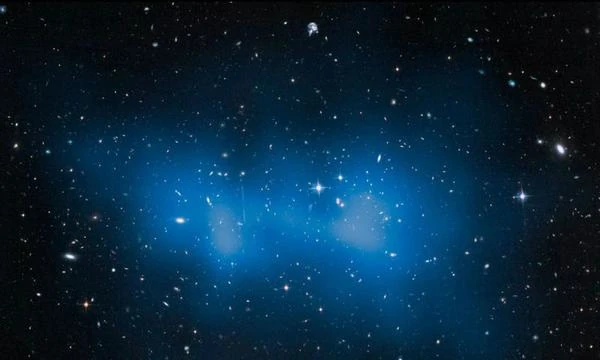
Image description: This Hubble mosaic shows the cluster called El Gordo (the fat one, in Spanish). The cluster contains several hundred galaxies, but in this image there are many more because some are seen distorted multiple times by gravitational lenses. They spread out in a circle but are only multiple views of a single galaxy. Credit: NASA, ESA, and J. Jee (University of California, Davis).
The El Gordo galaxy cluster, officially designated ACT-CL J0102-4915, is one of the most massive and energetic galaxy clusters observed in the universe. Located about 7 billion light-years away, this cluster was discovered in 2012 by an international team of scientists using the Atacama Cosmology Telescope (ACT) in Chile. Its name, "El Gordo," which means "the fat one" in Spanish, reflects its enormous size and immense mass, estimated at about 3×1015 solar masses. El Gordo's size is impressive, with a diameter of about 3 million light-years.
El Gordo is made up of thousands of galaxies, hot gas, and dark matter (observed by X-rays). About 85% of the cluster's mass is in the form of dark matter, a hypothetical form of matter that does not interact with light but whose presence is inferred from its gravitational effects.
X-ray observations, carried out by the Chandra X-ray Observatory, reveal that the hot gas in El Gordo has an average temperature of about 14 keV (about 160 million degrees Kelvin). This high temperature is indicative of the violent dynamics of the cluster, often attributed to a collision between two smaller clusters.
One of the main methods used to study El Gordo is the Sunyaev-Zel'dovich (SZ) effect. This effect occurs when the cosmic microwave background (CMB) radiation interacts with the hot gas of the cluster, shifting the energy of the CMB photons. This interaction allows the cluster to be detected and some of its properties, such as the pressure of the hot gas, to be measured.
El Gordo also acts as a gravitational lens, bending the light of objects behind it. By observing the distortions of the images of background galaxies, astronomers can map the mass distribution in the cluster, including dark matter. This technique has been used to confirm El Gordo's immense mass and to study its internal structure.
X-ray observations are essential for studying the hot gas in galaxy clusters. Data from the Chandra X-ray Observatory have made it possible to measure the temperature, density, and distribution of the hot gas in El Gordo, providing clues about the cluster's dynamic history and ongoing merger processes.
The study of El Gordo provides important tests for cosmological models. The cluster's extreme mass and size, as well as its existence at a relatively early epoch in the universe, challenge some predictions of standard structure formation models. Cosmologists use clusters like El Gordo to refine the parameters of the standard cosmological model, including the density of dark matter and the nature of dark energy.